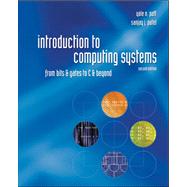
| Welcome Aboard! | |
| Bits, Data Types, and Operations | |
| Digital Logic Structures | |
| The Von Neumann Model | |
| The LC-3 | |
| Programming | |
| Assembly Language | |
| I/O | |
| TRAP Routines and Subroutines | |
| And, Finally... | |
| Introduction to Programming in C | |
| Variables and Operators | |
| Control Structures | |
| Functions | |
| Debugging | |
| Recursion | |
| Pointers and Arrays | |
| I/O in C | |
| Data Structures | |
| The LC-3 ISA | |
| From LC-3 to x86 | |
| The Microarchitecture of the LC-3 | |
| The C Programming Language | |
| Extending C to C++ | |
| Useful Tables | |
| Table of Contents provided by Publisher. All Rights Reserved. |
The New copy of this book will include any supplemental materials advertised. Please check the title of the book to determine if it should include any access cards, study guides, lab manuals, CDs, etc.
The Used, Rental and eBook copies of this book are not guaranteed to include any supplemental materials. Typically, only the book itself is included. This is true even if the title states it includes any access cards, study guides, lab manuals, CDs, etc.